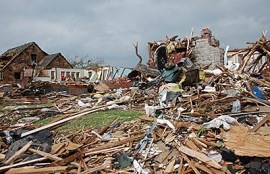
by Shane Henson — December 2, 2013—Nationally accepted standards for building design and construction, public shelters and emergency communications can significantly reduce deaths and the steep economic costs of property damage caused by tornadoes. That is the key conclusion of a two-year technical investigation by the U.S. Commerce Department’s National Institute of Standards and Technology (NIST) into the impacts of the tornado that struck Joplin, Missouri, on May 22, 2011.
The recommendations are featured in a draft report newly issued for public comment. The NIST study is the first to scientifically assess the impact of a tornado in four major categories: tornado characteristics, building performance, human behavior and emergency communication, as well as the impact of each on life-safety, the ability to protect people from injury or death. It also is the first to recommend that standards and model codes be developed and adopted for designing buildings to better resist tornadoes, says NIST.
In regard to building performance, in the majority of cases, the study found that regardless of construction type, buildings did not adequately protect occupants and that Joplin residents had limited access to underground or tornado-resistant shelters. The majority of deaths (135 or 83.8 percent) were caused by impacts associated with building failure. Virtually all of the buildings in which people died were affected by wind speeds equivalent to an EF-3 tornado or higher on the Enhanced Fujita scale.
Other findings include that multiple factors contributed to a delayed or incomplete response by people in the tornado’s path, including lack of awareness of the tornado’s approach, confusion about or distrust of the emergency messages prior to the tornado’s arrival, and an inability to perceive risk due to the conflicting information. While outdoor siren systems prompted many residents to seek further information about whether or not there was a true hazard, people were often confused by multiple information sources.
Based on these and other findings from the investigation, NIST developed 16 recommendations for improving how buildings and shelters are designed, constructed and maintained in tornado-prone regions; and for improving the emergency communications that warn of imminent threat from tornadoes.
The key recommendation proposed in the report is “the development and adoption of nationally accepted performance-based standards for the tornado-resistant design of buildings and infrastructure to ensure the resiliency of communities to tornado hazards.” This includes a call for designing and constructing essential buildings—such as hospitals and emergency operations centers—and infrastructure to remain operational in the event of a tornado. Additionally, the report’s authors recommend the development of methods that will ensure all building components and systems meet the proposed performance objectives.
The report also recommends uniform national guidelines be developed that enable communities to create the safest and most effective public sheltering strategies. Shelters, the report states, should be installed in new and existing multi-family residential and commercial buildings, schools and in buildings with assembly occupancies (such as theaters and places of worship) located in tornado hazard areas.
Also needed are nationally accepted codes and standards, as well as uniform guidance for clear, consistent and accurate emergency communications, according to the report. The NIST report also includes a number of recommendations for future research and development of technologies and strategies to advance tornado wind measurements, strengthen emergency communications, increase warning time, derive more accurate tornado hazard maps, and significantly improve public response during tornado events.
Following the public comment period, NIST will issue a final report and then work with the appropriate code development organizations to use the study’s recommendations to improve model building codes and lay the foundation for nationally accepted standards. NIST also will work with organizations representing state and local governments—including building officials—to encourage them to seriously consider implementing its recommendations. For more information about the study and report, watch the NIST news conference on YouTube.




